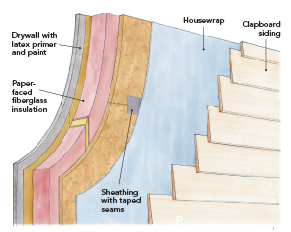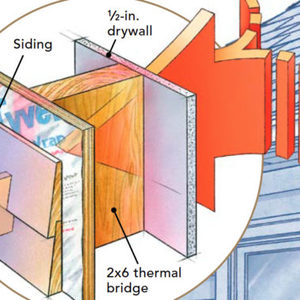
The drawing above shows what may be the most commonly wall built in America today, with some slight variation from one climate zone to another and from one builder to another. This wall is framed with 2x4s or 2x6s on 16 inch or 24 inch centers. It is sheathed with OSB or plywood. The wall cavities are filled with fiberglass insulation and the sheathing is covered with a mechanically fastened water-resistive barrier, probably Tyvek HomeWrap. In colder climates the wall will have an interior vapor retarder and in warmer climates, it won’t. Any remotely energy-conscious builder, or any builder working where air-tightness is confirmed with a blower door test, will tape the sheathing seams with air sealing tape. Most, unfortunately, don’t.
This wall works. If it is built and detailed well, it won’t fail due to water intrusion or condensation resulting from air leaks or vapor drive. In some areas, however, you cannot meet current R-value requirements of the building codes with this wall, and it is certainly not a high-performance wall. Green builders know that code minimum R-values are often not high enough to create an energy efficient and comfortable home. They also know that continuous insulation not only improves whole-wall R-values, but overall durability as well. And they need solutions for retrofit situations where air sealing and insulating goals are more challenging to meet.
This collection of articles will answer the most common questions about wall design and point you towards a number of wall assemblies that work in a variety of climate zones. And in this case “work” means create an energy-smart, healthy, comfortable, and durable home.
-
Five Rules for Wall Design
A typical high-performance house has walls with multiple layers. Some layers are vapor-permeable, while others restrict vapor movement. Some layers have a significant R-value; others provide little insulative value. Understanding whether a proposed wall system will work in your particular climate can be tricky. This article can help.
-
Five Walls that Work
If you cruise the GBA Q&A section it will quickly become clear that, for some reason, people are drawn to trying to reinvent the wall with all sorts of wild ideas for their projects. If you've got the time and you've got the inclination, there's no harm in designing alternative wall assemblies. But it's usually not necessary. This article takes a look at a few wall assemblies that are straightforward to build and proven to work.
-
The Four Control Layers of a Wall
Every wall is a combination of materials with the goal of keeping rain outside, conditioned air inside, heat in (in the winter) and out (in the summer), and preventing vapor drive into the assembly while allowing materials to dry when they get wet. When you understand these control layers, you understand and can design, build, and remodel walls confidently.
-
How to Design a Wall
In most of the U.S. and Canada, there are two cost-effective ways to build a wall with an R-value that exceeds minimum code requirements. The first approach is to build a double-stud wall. The second approach is to build a 2×6 wall with a continuous layer of insulation (usually rigid foam or mineral wool) on the exterior side of the wall sheathing. Here's a look at the pros and the cons of each of these approaches with helpful details to make sure whichever wall you build, you get it right.
-
A Case for Double-Stud Walls
A builder with over a decade of experience with double-stud walls shares the many reasons why this has become his go-to assembly, despite some (unproven in his work) concerns raised by his peers. The article includes a step-by-step look at his process for framing the two walls that make up the assembly.










